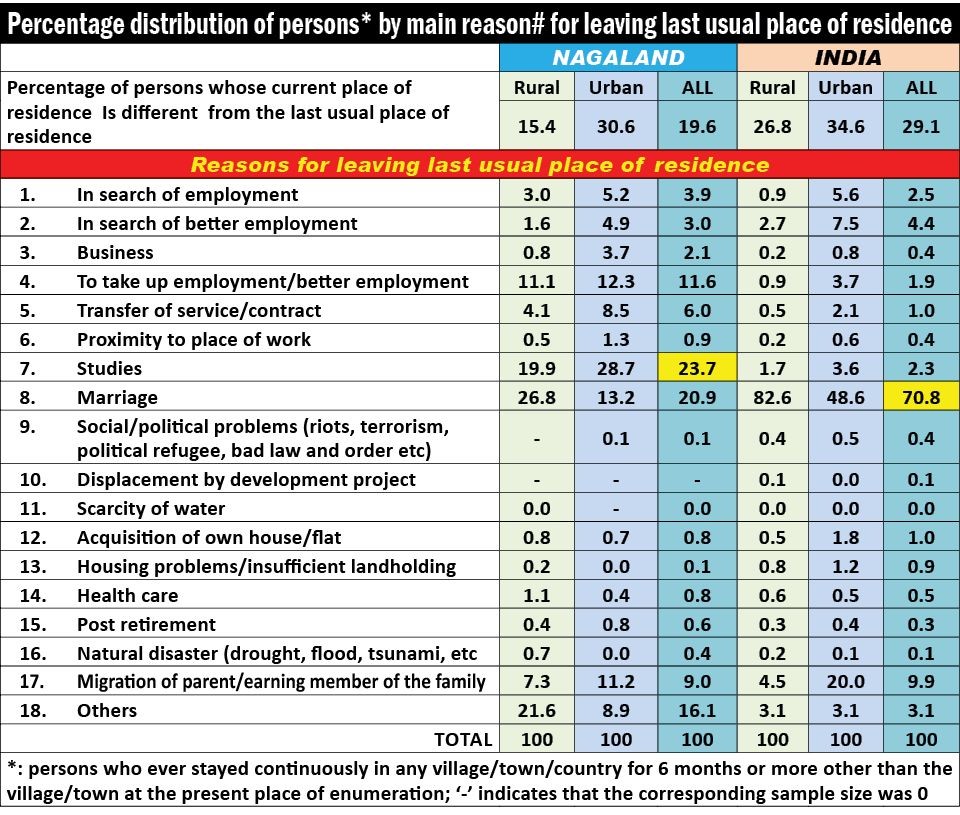Multiple Indicator Survey in India, NSS 78th Round (2020-21), Ministry of Statistics and Programme Implementation, National Sample Survey Office

Moa Jamir
Dimapur | March 19
At 23.7%, the single largest driver of migration or persons moving from ‘usual place of residence’ to others areas in Nagaland is due to studies, while the instance of women changing their place of domicile is significantly higher than their male counterparts.
These, among others, are some of the data reflected in the recent 'Multiple Indicator Survey in India' (MIS) conducted by the National Sample Survey Office (NSSO) under the Union Ministry of Statistics and Programme Implementation (MOSPI).
All together, the NSSO’s 78th round survey conducted from January 2020 to August 15, 2021 across India found that 19.6% of the population in Nagaland were staying in a new place other than their last usual place of residence.
Of the many reasons cited for migration, marriage was also another big driver, though there were significant differences between men and women.
Among those migrated in Nagaland, 20.9% moved to their current place of residence due to marriages, informed the MIS Survey for 2020-21 released on March 7.
The data from Nagaland is a huge departure from the national average of the single most significant reason behind migration was given as marriage at 70.8%.
The overall migration rate or ‘percentage of persons whose current place of residence is different from the last usual place of residence’ in India was 29.1%.
Unlike Nagaland, ‘studies’ as a reason for migration was just 2.3% across India.
Other drivers
Meanwhile, the third largest reason for migration in Nagaland was ‘To take up employment/better employment’ at 11.6%.
Other big specific contributors were also employment related such as Migration of parent/earning member of the family (9%); Transfer of service/contract (6%); In search of employment (5.2); In search of better employment(4.9%); and Business (3.7%).
Shifting of domicile due Social/political problems, Displacement by development project; Scarcity of water, Post retirement, Natural disaster etc were negligible and there were no ‘Displacement by development project.’
16.1% of the migration in Nagaland had no specific reasons and designated as ‘Others.’
As stated, the national average was dominated by relational affairs, with ‘Migration of parent/earning member of the family’ coming at second at 9.9%, after marriage.
Collectively the two reasons contributed to nearly 81% of total migration across India.
Other significant reasons were employment related such as - In search of better employment (4.4%); ‘In search of employment’ (2.5%)To take up employment/better employment (1.9%); and Transfer of service/contract (1%). A total of 3.1% was given as others. (See Table)
Male-female attributes
One of the highlights reflected by the MIS data on migration was the apparent precedence of males’ concerns over their females’ counterpart.
For instance, in Nagaland, out of 19.9% total female migration, 39.7% was due to marriages, while 11.7% was due to related migration of parent/earning member of the family, signifying over half of the total of their total migration. A total of 23% of females also migrated from their residences due to studies.
In contrast, out of total 19.5% male migration in Nagaland, marriage contributed to just 3.3% while due to migration of parent/earning member of the family was just 6.4%.
For males, ‘Studies’ and ‘To take up employment/better employment’ at 24.3% and 17.5% respectively had the highest share of reasons behind their migration.
A total of 10.4% was also due ‘Transfer of service/contract.’
However, the findings pale in comparison with the all-India status.
As per the report, out of 47.7% of females shifting out of their place of domicile, 87% was due to ‘Marriage.’
Taken together with ‘migration of parent/earning member of the family’ at 8%, an astonishing 95% was due to marriages or family related matters.
On the other hand, just 5.8% of male migration was due to marriage, while 17.1% was due to ‘migration of parent/earning member of the family.’






